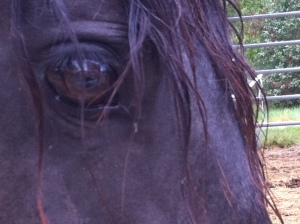Day 16-22
This week I didn’t get as much done as I hoped between the searing heat outside and injuring my foot. My Friesian cross gelding, Dragon, “spooked in place” and just onto my foot while leading him from his pasture to the barn in the dark. In sandals. I know it is a cardinal rule to always wear boots around horses. I got lazy: it was late at night and the toe protectors on my sandals lulled me into a false sense of security. Lesson learned.
Djinn and I had some wonderful training sessions and then a few harder ones. Towards the beginning of the week I had a man come out to pull some sand out of our arena so the footing would be a bit firmer. Djinn worked on targeting while he drove the equipment and she had beautiful concentration and great duration. I was amazed at how easily she focused and how well she handled the noise which has upset her in her past. Her emotional control was seeming of a different order and I felt sure we had moved into new territory. A new place where I could ask more of her and she could handle more environmental stress without it affecting her response.
Then, on Saturday when we trained it was starting to get dark and people’s voices were carrying through the fields as well as some unfamiliar barking dogs. Someone was shooting a loud gun in the distance and overall the farm felt rather unsafe. Normally it’s perfectly quiet here.
I worked with Djinn anyway despite the stressful environment because I thought her behaviors would hold up and I had committed to working with her daily. I thought working on her target behavior would give her something to focus on and settle her down. While she was able to touch her target, she was stressed and ended up biting the target a lot. I lowered my criteria to just nose touches and ended on a good note.
When I went out to train her on Monday, I got this:
You can see in the video how Djinn is a bit frantic about getting to her target and opens her mouth wide to bite it as her first behavior. Yikes! This is not the emotional state I am looking to get out of this behavior. Instead of settling in and focusing on touching her target, she gets more and more frustrated, biting and finally cantering off . It’s up to me as the trainer to help Djinn calm down. I decided to go back to the first thing I taught her, head down, and reinforce her heavily for maintaining the position. There’s not a lot of research behind it, but theoretically, since horses have their head on the ground when grazing and grazing is relaxing, putting their head down helps them access a more relaxed, calm emotional state. Here’s Djinn doing her head down:
This video starts when we’ve been doing head down already for about a minute. It’s boring, so I edited that part out. (If you really want to see it, I have the footage in my computer.) The reason I included this clip is at about :17 seconds you see Djinn raise her head to look off to her right. She is concerned, but lowers her head uncued and then and :23 gives a blow through her nose which indicates relaxation. From there I take here through walking forward and back so she can practice moving in a controlled way. She blows again at :31 and is more relaxed from then on. This is a good thing! I want a horse who understands how to self-calm when nervous. Lowering your head is much better than rushing off or biting.
In traditional horse training, we seek to make the horse obey regardless of internal states. In progressive horse training, we use internal states as a guide in our training. I don’t want my horses to suppress their fear because what is suppressed tends to reappear at the most inopportune times. I want my horses to express their emotions so I can teach them a million roads out of their fear and frustration. Roads we can walk together.
You can see when we go back to targeting she is less frantic and more focused. Still not as good as the days before, but much improved. For my part, I lowered the target so that she can keep her head lower when touching the ball. It will keep her back from inverting and tensing up. I also kept the target closer to her so she wouldn’t feel any frustration about the target “getting away” which could also lead to the biting behavior. With these two changes, plus the break for head lowering Djinn does much better!
I love that this whole sequence is on video. So many trainers just show finished behaviors and it can feel so frustrating when your horse isn’t “textbook”. Here you can see that Djinn is having an emotional day and I am getting all sorts of behavior I don’t think is useful for a relaxed horse/human relationship. We just go back to basics, make her job easier, and find a way to allow her to be right. As my mentor Alexandra Kurland says,” You don’t know what the horse has learned, we only know what we’ve presented.” I think I did a good job taking Djinn back to basics. She’ll tell me this week through her behavior. Stay tuned!

